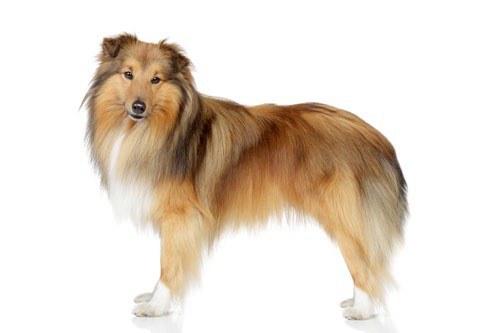Shelties are widely recognized and admired for their stunning coats and lovely colors. But a gorgeous coat is not created by grooming overnight, and not every Sheltie can grow and maintain a fabulous, sensational coat. A beautiful coat is the result of excellent health care, high-quality nutrition, and the right combination of genes (inheritance).
Shelties have a double coat. The outer coat is harsh, straight, and long. The undercoat is short, furry, and dense and adds to the coat’s “standoff” appearance. Surprisingly, despite the thick undercoat and large amount and length of hair, a healthy Sheltie’s coat requires very little in the way of equipment or products to keep it looking great. The key is to brush the
coat thoroughly, from the skin out, at least once a week. This keeps the skin healthy and maintains the coat in top condition, free of mats and tangles.
Of course, if your Sheltie goes outside and runs through fields and accumulates weeds, seeds, stickers, parasites, dirt, and debris in his coat, then his coat will need a thorough brushing that same day. The longer you wait, the more difficult your pet’s coat will be to groom, and mats will form. Mats cause the coat to lose its insulating ability and also make ideal hiding places for parasites. Mats create a moist environment where bacteria can multiply and where skin sores and “hot spots” can quickly develop.
When your Sheltie is shedding large quantities of hair, especially the undercoat, he may need daily brushing until the coat has shed out completely (breeders call this “blowing coat”) and the new coat has started to replace it. During heaving shedding, the undercoat can come out in larger cottony clumps. This is normal.
Shelties love to be groomed. They thrive on the personal attention they receive from their owners during grooming sessions, and they surely feel much better after a stimulating, refreshing brushing. Grooming is good for your Sheltie, and it can be good for you, too. It can be a fun form of relaxation. It has benn well documented that touching and caressing a dog can help lower blood pressure. Studies have also shown that when people touch their dogs, oxytocin (a hormone that plays an important role in bonding, trust, stress reduction, and a desire for social connection) is released in both the owner and the dog. Grooming strengthens the friendship bond between you and your Sheltie!
Growing a Show Coat
A beautiful show coat starts when you purchase your Sheltie from a reputable breeder. Coat quality, density, length, texture, and color are inherited from the parents. If your Sheltie did not inherit the genes that produce a stunning show coat, then all the products in the world (shampoos, rinses, nutritional supplements, brushes, and combs) won’t produce a champion show coat. This doesn’t mean that your Sheltie won’t benefit from special hair care and products to help him look and feel his very best. He will! It simply means you must be realistic in your expectations.
Hair Growth
The important relationship between hair growth and high-quality nutrition cannot be overemphasized. Hair is made up of almost solid protein, called keratin. A balanced diet containing high-quality, digestible protein is
essential for your Sheltie to grow a beautiful coat.
Your Sheltie’s hair grows in cycles. The active growth cycle is called the anagen phase. The catagen phase is a transitional period leading to the resting phase. The telogen phase is when hair is retained in the hair follicle as “dead hair.” This dead hair is eventually shed. Dogs typically shed in a mosaic pattern throughout the body. Brushing removes dead hairs, stimulates the skin, and distributes natural oils in the coat.
During the anagen phase, a single hair grows only .1 to .2 mm each day. However, if you multiply that distance times the hundreds of thousands of growing hairs on your Sheltie’s body, that totals more than 50 feet (15 m) of hair growth each day! A Sheltie in poor health or receiving an inadequate diet can have delayed or arrested hair growth, a dull coat, and weak hair that breaks easily.
Shedding
Depending on geographical location, photoperiod, weather, and seasons, most Shelties tend to do their major shedding during the summer. The new coat grows in during the early fall and attains full glory during the winter months. This makes sense, because a heavy coat would be needed most in winter. However, not all Shelties fit a specific pattern for coat growth and hair loss. For example, after a female gives birth to a litter, she normally sheds her coat six to eight weeks later. This hair loss is called post-partum effluvium and is entirely normal.
A Sheltie with the genetic potential to grow a gorgeous coat will not be able to do so unless it is in excellent health, receives the best of care and nutritious food, and the environmental conditions are just right. When a Sheltie is sick, stressed, fed an inadequate diet, or has some hormonal imbalances, the coat may shed excessively and not grow.
Many skin and hair problems are caused by poor nutrition, food allergies, parasites (internal and external), fungi, harsh chemicals or inappropriate products used on the skin, allergies to synthetic bedding material, or an unsanitary damp environment. Shelties can also develop dry, flaky skin during the winter when they are exposed to the drying effects of heaters, radiators, and fireplaces.

